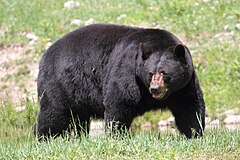Ursinae
podrodzina ssaków
Ursinae – podrodzina ssaków z rodziny niedźwiedziowatych (Ursidae).
| Ursinae | |||||
| G. Fischer, 1817[1] | |||||
 Przedstawiciel podrodziny – niedźwiedź czarny (Ursus americanus) | |||||
| Systematyka | |||||
| Domena | |||||
|---|---|---|---|---|---|
| Królestwo | |||||
| Typ | |||||
| Podtyp | |||||
| Gromada | |||||
| Podgromada | |||||
| Infragromada | |||||
| Rząd | |||||
| Podrząd | |||||
| Infrarząd | |||||
| Nadrodzina | |||||
| Rodzina | |||||
| Podrodzina |
Ursinae | ||||
| Typ nomenklatoryczny | |||||
|
Ursus Linnaeus, 1758 | |||||
| |||||
| Rodzaje | |||||
| |||||
Zasięg występowania edytuj
Podrodzina obejmuje gatunki występujące w Eurazji, Ameryce Północnej i Arktyce[15].
Podział systematyczny edytuj
Do podrodziny należą następujące występujące współcześnie rodzaje[16][15][17]:
- Helarctos Horsfield, 1825 – biruang – jedynym żyjącym współcześnie przedstawicielem jest Helarctos malayanus (Raffles, 1821) – biruang malajski
- Melursus F.A. Meyer, 1793 – wargacz – jedynym żyjącym współcześnie przedstawicielem jest Melursus ursinus (G. Shaw, 1791) – wargacz leniwy
- Ursus Linnaeus, 1758 – niedźwiedź
Opisano również rodzaj wymarły[18]:
- Aurorarctos Jiangzuo Qigao & Flynn, 2020 – jedynym przedstawicielem był Aurorarctos tirawa Jiangzuo Qigao & Flynn, 2020
Uwagi edytuj
Przypisy edytuj
- ↑ a b J.G. Fisher von Waldheim. De systemate Mammalium. „Mémoires de la Société impériale des naturalistes de Moscou”. 5, s. 372, 1817. (łac.).
- ↑ G. A. Goldfuss: Handbuch der Zoologie. Cz. 2. Nürnburg: Johann Leonhard Schrag, 1820, s. xx. (niem.).
- ↑ J.E. Gray. On the Natural Arrangment of Vertebrose Animals. „The London Medical Repository”. 15, s. 301, 1821. (ang.).
- ↑ a b J.E. Gray. An Outline of an Attempt at the Disposition of Mammalia into Tribes and Families, with a List of the Genera apparently appertaining to each Tribe. „Annals of Philosophy”. New Series. 10, s. 339, 1825. (ang.).
- ↑ S.D.W.. The mammals of Britain systematically arranged. „The Analyst”. 4, s. 70, 1836. (ang.).
- ↑ Ch.G.A. Giebel: Die säugethiere in zoologischer, anatomischer und palæontologischer beziehung umfassend dargestellt. Leizpzig: A. Abel, 1855, s. 736. (niem.).
- ↑ S.F. Baird: Mammals. W: United States. War Department: Reports of explorations and surveys, to ascertain the most practicable and economical route for a railroad from the Mississippi River to the Pacific Ocean. Made under the direction of the secretary of war, in 1853-1857. T. 8. Cz. 1: General report upon the zoology of the several Pacific Railroad routes. Washington: A.O.P. Nicholson, Printer, 1857, s. 206. (ang.).
- ↑ E. Haeckel: Generelle morphologie der organismen. Allgemeine grundzüge der organischen formen-wissenschaft, mechanisch begründet durch die von Charles Darwin reformirte descendenztheorie. Cz. 2. Berlin: G. Reimer, 1866, s. clix. (niem.).
- ↑ H. Burmeister. Fauna Argentina. Primera parte. Mamíferos fosiles. „Anales del Museo Público de Buenos Aires”. 1, s. 144, 1866. (hiszp.).
- ↑ E. Haeckel: Systematische phylogenie. T. 3. Berlin: Georg Reimer, 1895, s. 578, 585. (niem.).
- ↑ H. Winge: Jordfundne og nulevende rovdyr (Carnivora) fra Lagoa Santa, Minas Geraes, Brasilien: med udsigt over pungdyrenes slægtskab. Copenhagen: Bianco Lunos Kgl Hof-Bogtrykkeri, 1895, s. 47. (duń.).
- ↑ J.C. Merriam & Ch. Stock: Relationships and Structure of the Short-Faced Bear, Arctotherium, from the Pleistocene of California. W: Papers concerning the palaeontology of the Pleistocene of California and the Pliocene of Oregon. Nr 347. Washington: Carnegie Institution of Washington, 1925, s. 3. (ang.).
- ↑ Q.B. Hendey. A Pliocene ursid from South Africa. „Annals of the South African Museum”. 59 (6), s. 119, 1972. (ang.).
- ↑ R.H. Tedford. Relationship of pinnipeds to other carnivores (Mammalia). „Systematic Zoology”. 25 (4), s. 372, 1976. DOI: 10.2307/2412511. (ang.).
- ↑ a b C.J. Burgin, D.E. Wilson, R.A. Mittermeier, A.B. Rylands, T.E. Lacher & W. Sechrest: Illustrated Checklist of the Mammals of the World. Cz. 2: Eulipotyphla to Carnivora. Barcelona: Lynx Edicions, 2020, s. 434–436. ISBN 978-84-16728-35-0. (ang.).
- ↑ N. Upham, C. Burgin, J. Widness, M. Becker, C. Parker, S. Liphardt, I. Rochon & D. Huckaby: Treeview of Mammalian Taxonomy Hierarchy. [w:] ASM Mammal Diversity Database (Version 1.11) [on-line]. American Society of Mammalogists. [dostęp 2023-12-18]. (ang.).
- ↑ Nazwy zwyczajowe za: W. Cichocki, A. Ważna, J. Cichocki, E. Rajska-Jurgiel, A. Jasiński & W. Bogdanowicz: Polskie nazewnictwo ssaków świata. Warszawa: Muzeum i Instytut Zoologii PAN, 2015, s. 151–152. ISBN 978-83-88147-15-9. (pol. • ang.).
- ↑ Q.-g. Jiangzuo & J.J. Flynn. The earliest ursine bear demonstrates the origin of plant-dominated omnivory in Carnivora. „iScience”. 23 (6), s. 2, 2020. DOI: 10.1016/j.isci.2020.101235. (ang.).
Identyfikatory zewnętrzne: